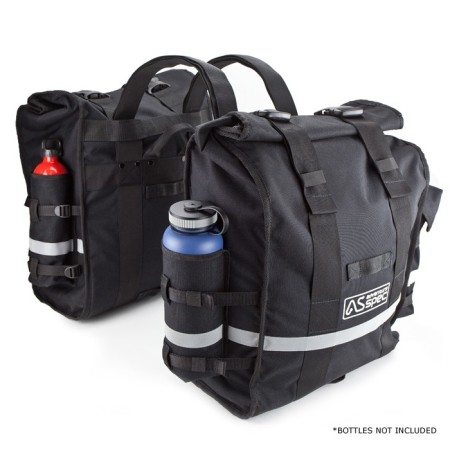
New aspirations: Less is more and size does matter
So why have we gone soft in our old age when aluminium panniers sustained us for a good portion of our ‘bottom up’ trip of the Americas? A few good reasons really. Allow me to explain, not without gusto. During extensive research into the best bags on the market for our evolving needs encompassing ‘Less is more’—one can’t help but come across Walter Colebatch: world motorcyclist explorer who thrives on discovering hardcore routes in remote wildernesses.
Pioneering the British-made Magadan MK2s with the one-stop motorcycle shop, Adventure-Spec, Colebatch employed an impressive material that hits the jackpot for being waterproof, slash-proof and abrasion resistant, where the finished article can even be made secure. Foremost less leaden coupled with the above, certainly checked a lot of my boxes from the outset—hoping they would stay ticked on the road.

Weight and sanity: a positive correlation
Despite the many and valid arguments for hard panniers, the pair of us have grown weary of pumping iron on a gruelling basis to keep up with the muscle mass required in picking up the GSs. Instead–and swopping the bikes for lighter models will be the next natural step in the process–Jason and I agreed that it was high time we shaved a load off. Namely struggling with 530lb (240 kilograms) of F800GS laden with luggage and marginally less on mine, an F650GS: enough to give anyone a hernia and a joyless endeavour at altitude, in sand, on cambers, and let’s face it, wherever when the bike topples. Simply, when off road the saddlebags come into their own.
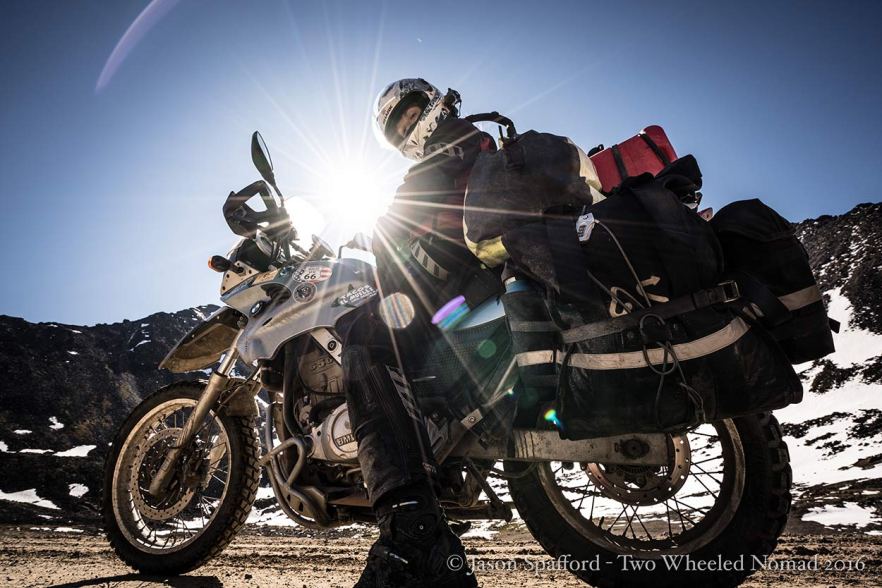
Installation and customer service
The install was speedy, straightforward and executed without a trace of fuss. The bags slotted onto the rack previously used for the hard panniers (usefully keeping them away from the side panels, wheels and exhaust), with Velcro top straps to support them over the rear seat of the bike. The bags are designed to work with any traditional ‘hooped’ racks such as those from Metal Mule units or Touratech, although the bags can accommodate many brands of racks for hard luggage: if the bars on which the boxes rest are flat, you should be fine. (If in doubt enquire via email with a picture and Adventure-Spec will confirm.)
Stabilising each of the bags with a tension strap (not included) stops any shifting, flapping or sagging while riding. Pleased with the fit and finish, the panniers looked fit-for-purpose in preparation to transport our equipment on the second leg of our two-wheel jaunt to the top of the planet. Should anything wear out, it’s good to know that field serviceability can be undertaken if the buckles get damaged. Alternatively, replacements can be ordered and shipped, or company repairs made. Firsthand experience shows that Adventure-Spec willingly ship internationally where the after-sales service has always been managed efficiently and effectively.
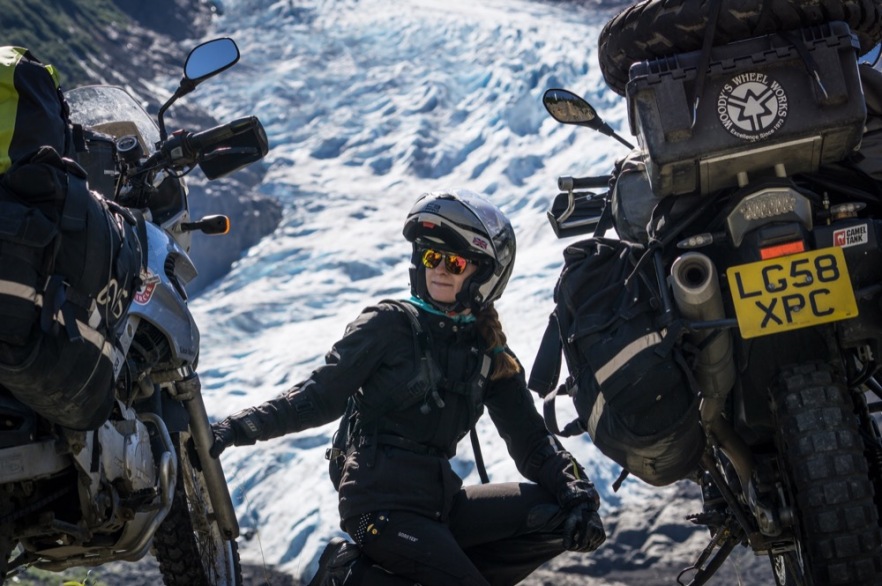
Construction
Like any luggage, backpack, motorcycling suits and other performance apparel or military wear worth its salt, the incorporation of Cordura will be present. Well known for its durability and resistance to abrasion, tearing and scuffing, its reputation precedes it. Where my current motorcycle suit enjoys 500 denier Cordura, the Magadans boast 1000 denier. Coupled with Kevlar / Twaron fabric makes them twice as thick and myriad times as strong respectively—their integrity would doubtless be unaffected if not practically immune in sliding down the highway.
Perhaps the toughest solution on the market with regards to an endless supply of ruggedness and longevity. The straps on the MK2s have been redesigned and the buckles are super-sized, giving further peace of mind to the bag’s endurance over a long life span.
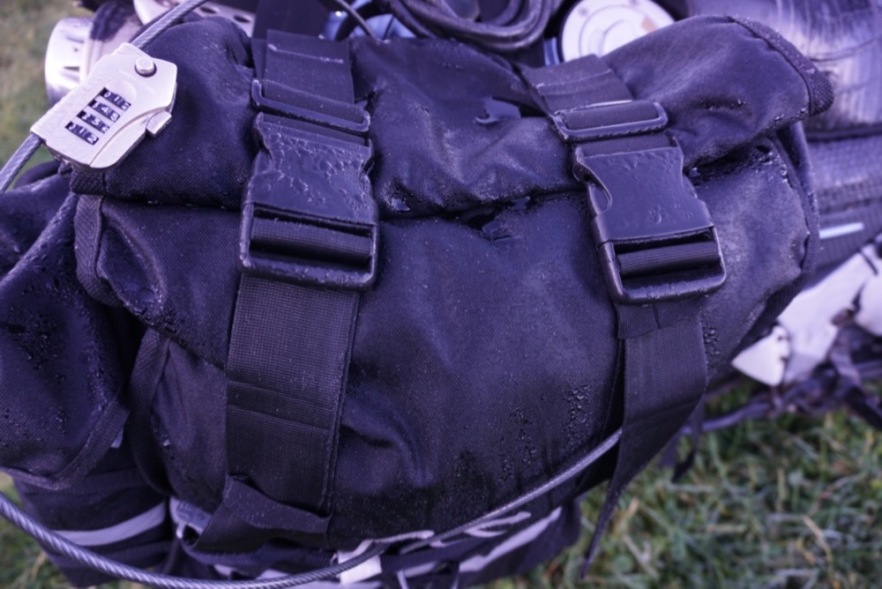
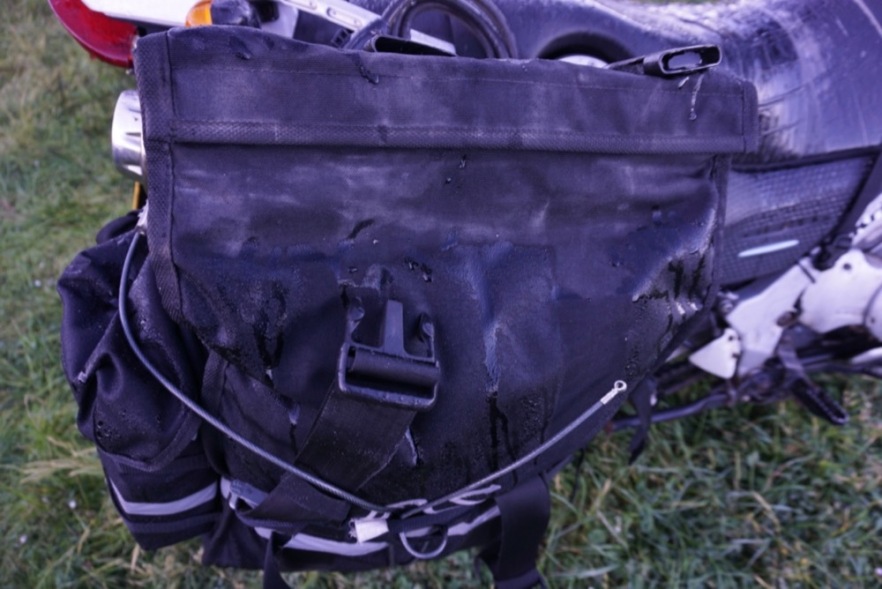

Storage
Many might fervently disagree but for me, the larger hard panniers promote over-packing and place unnecessary strain on my bike’s stock suspension. The 35-litre capacity of the saddlebags may have forced me to take less—sure, I’ve had to be strategic in streamlining my travel ensemble—but at least they alleviate the stress of having to art-precision pack each day with the volume I was carrying before. Always a joyless endeavour.
Thoughtful details added include two outside adjustable pockets on the front and the same on the back of the expandable bags: ideal for carrying a 24oz bottle / flask in the former and smaller items such as hat, winter or summer riding gloves, neck buff, batteries, charger and a multi-tool in the latter. Even a book and an 18oz food flask for your roadside lunch breaks.



The transitional period
Some people enjoy the sizable 45-litre pannier system, others don’t need side luggage at all and somehow manage to stow everything on the back. That’s different riders on varying types of trips and riding disciplines for you. As someone that’s somewhere in the middle—I’m not down to the clothes on my back just yet although perhaps err towards the off road routes more than the asphalt.
Consequently we underwent a significant overhaul of our gear after 20-months on the road and replenished if not refreshed virtually everything; most of which had expired after nearly two-year’s constant usage. If not battered to oblivion, courtesy of the vibrations from uneven road surfaces against 2mm-thick aluminium through 17 countries and over thousands of miles. Great! It only took us 608 days to learn those ‘hard’ lessons on the road.
In keeping with ‘Less is more,’ ‘Size does matter’ and congruent to Colebatch’s logic “The bigger the bags are, the more weight you can get down low, and the smaller your back bag needs to be”—I swopped a 90-litre roll bag for a 60-litre one. The resultant outcome hasn’t resulted in forfeiting anything we actually needed but indeed, oodles that I wanted. Suck it up, buttercup.

First impressions
Having made some inroads into hurling as much abuse as possible at the MK2s over the last 7-months, they’ve been subjected to wear and tear on an almost daily basis. Riding all day in the saddle through cactus-laden desert in California, up to 7,000 feet in Arizona’s mountainous regions, through the Canyonlands of Utah and into Colorado’s ice-cold climes. A month on the Baja Peninsula’s trails in dry, sand- and wind-blasting conditions, through Kanab’s sleeting snow to downpours that froze on impact in Flagstaff, and as far north as Alaska.
Put further through their paces in: Death Valley’s thick gravelly washes and over skull-jarring corrugations, where the bags remained unaffected in temperatures from below freezing through BC and Yukon in Canada’s springtime, to a searing 103F at Furnace Creek, California concluded my initial appraisal. So far, so good.

Waterproofing
Without question, the MK2s have effortlessly weather-sealed our belongings. Period. And no gnawing doubt ever surfaced on the emergence of water. (That said, I still keep everything inside free of moisture in dry bags.) Two removable, heavy-duty yellow dry bag liners (included) give rise to the aforementioned peace of mind.
Sealed at the opening with industrial-strength Velcro, and rolled down a couple of times, my belongings remain as waterproofed and dust-free as they did in the former foam rubber-lined boxes. It’s a joy to report that the weatherproofing of the saddlebags continues to perform admirably after hours of rain lashing down on them, leaving our contents bone-dry and sanity levels intact.
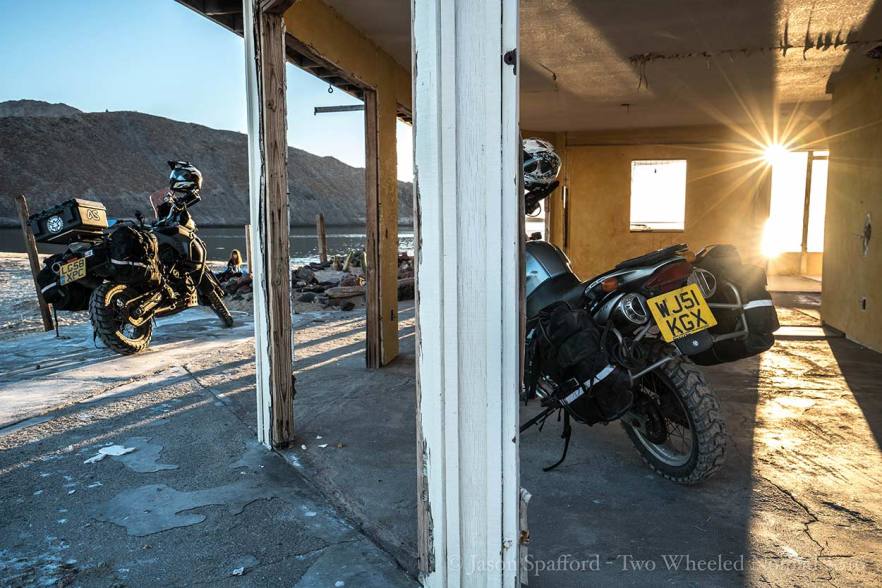
The bikes are remarkably happy here, as are we
Security
Perhaps the biggest challenge of all: security of soft luggage. Where most saddlebag solutions are lacking in deterring the odd opportunist, the Magadan MK2s are lockable. Employing devices such as the Pacsafe Wrapsafe Anti-theft Adjustable Cable Lock or Lifeventure Sliding Cable Lock (neither included) for instance, not only secures the bags but locks the bags to the luggage rack as well. The cable subtly routes through various heavy-duty loops on the front and back—firmly fastening down the bag and materialising Colebatch’s desired intention of “the first motorcycle soft bags that actually offer some sort of security and lockability.” However, a determined enough thief might still get in them, but I think the right implement in the hands of the wrong person, they could do the exact same with hard panniers too.
Likely the cable locking system is enough to discourage most unsavoury types out there, but what’s to stop them gliding a knife into the hot butter of your contents? The bags are also slash-proof. An internal wire mesh was brought into consideration during the R&D process, although sandwiching a layer of Kevlar / Twaron into the construction was actually incorporated. Remarkably challenging to cut, the same materials are used in UK police officer’s stab-proof and bulletproof vests where the resultant puncture resistance further heightens the robustness of the bags.

Living with the panniers
The dry bag liner’s vibrant colour facilitates easy access to one’s things, as opposed to rummaging in a well of black for instance. Ideal when you need to grab something quickly on the road, add a layer or remove one. The liner can be whipped out smoothly and taken into your accommodation without any fuss, which is highly convenient. It’s heaven sent as opposed to dragging a waterlogged bag dripping with mud into your tent or hotel. Dependent on how full-to-capacity the bag liner is, for me, it’s easier to slide it into the saddlebag first, and then pack up with my luggage items.
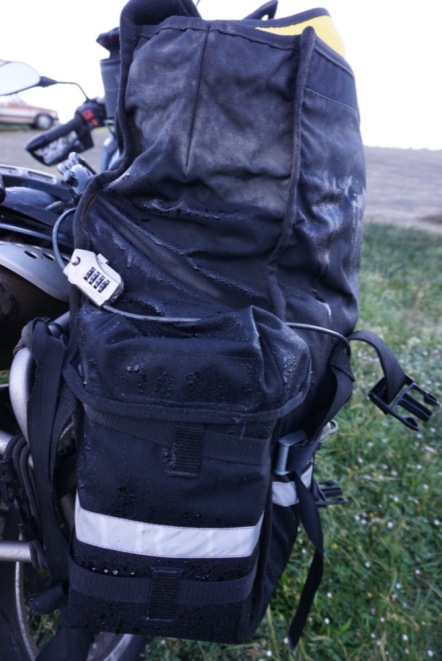
My inner-hoarder that previously condoned carrying excessive clothing, toiletries and a small library (having resisted becoming a Kindle convert) has gloriously gone into hibernation. Where soft side luggage is concerned, I’ve had to be mindful in my packing by stashing the breakables in a tank bag or the roll bag on the back; a red wine explosion, toothpaste rupture or cracked laptop when the bike tips over would be about as fun as a funeral. Padded organisers, lightweight garment mesh bags and thin dry bags (with terrific tear-strength) have proved priceless; the alternative being to rummage for the needle-in-a-big-inner-bag haystack.
In the event of a low-speed “offy” or on a crash impact, my legs are far less likely to buckle under the hammering of saddlebags falling on top of them. While the width and sturdiness of hard boxes can save damage to the motorcycle and harm to the limbs—having trapped my legs beneath hard panniers and jumping back in the saddle unscathed—I’ve known several unfortunate individuals whose legs have come a cropper and been crushed because of the way they’ve fallen beneath their bike’s metal panniers.
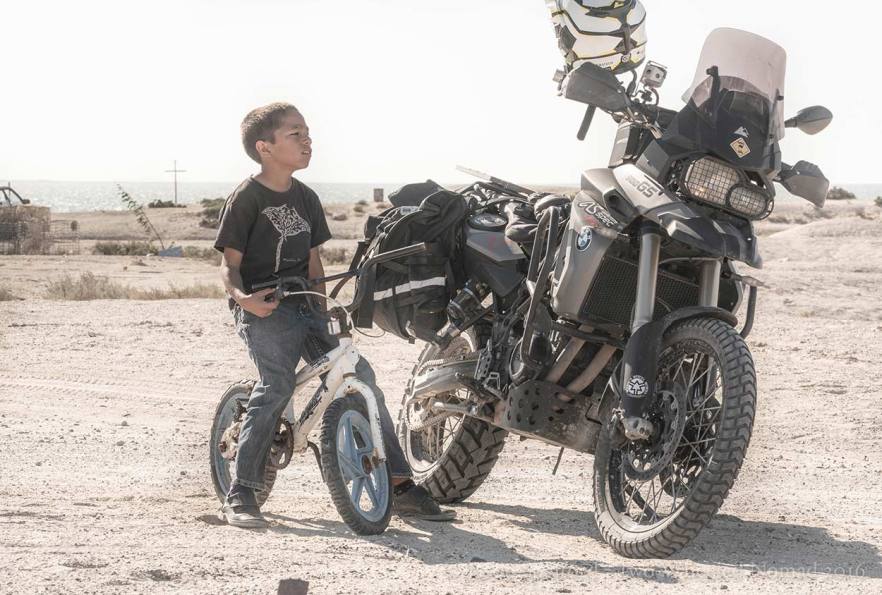
I’m free of worrying about whether my side luggage has sufficient flex to facilitate the absorption of energy created from the bike hitting the ground to the pannier. Namely the softness of saddlebags affords an easy transfer of energy from any crash impact to be absorbed by the bags, rather than something else. A cracked sub-frame for instance. Hence, the deadening vibration is far better managed through the bags, no longer killing my electronics over washboard corrugations to boot. I’ve also escaped the hassle of field repairs in bashing out any dents and dings with brute force: as incurred fairly frequently with the metal boxes throughout the gravel roads of South America—leaving one of them no longer rainproof.
Moreover, neither do rocks, stones, poles and anything else with the potential to catch on the flat front face of hard panniers overly concern me. The MK2s are far less likely to throw my motorcycle and me off course, nor break away from the rack. Neither does the stress exist previously incurred around destroying the metal brackets or bending if not breaking the affixing screws on a crash impact because I no longer possess any of them. Coupled with the laminated and embroidered reflective detailing on the front and sides that project excellent visibility at night in the oncoming headlights, further add to the saddlebags’ protection from danger, risk or injury.

Jason in his usual carefree mode, come rain, hail or wet calcium chloride.
Conclusion
Over 8,000 miles of: washboard corrugations, gravel, sand, dirt, mud and water crossings, the MK2s are sensational. They perform effectively in snow and ice as they do in the blistering heat, at 7,000 feet or -282 below sea level. I appreciate their Herculean strength, simple operation and weatherproofing; they do exactly what soft panniers are supposed to do.
Granted, while I’ve yet to test the luggage system’s adventure-proof qualities over a period of years, there’s no denying: they are significantly lighter, which is jubilant for us and even more joyful on the bikes’ suspensions. Ultimately, they make a lot more sense off road, not just because of reduced weight but for anywhere that involves: squeezing through tight spaces, negotiating the bike in between trees, down a narrow trail or brushing up against something that could fetch me off. Lane splitting is a joyful proposition when it’s legal, not to mention the enjoyment brought about by greater cornering clearance on the road.
The MK2s are practical, not pretty. Yet they’re fully featured and resilient to the extreme where a strong sneaking suspicion tells me these bad boys are built for the long haul. Perfect for wilderness-seeking motorcyclists, I’d unreservedly recommend the bags to anyone wanting soft luggage and value for money from their hard-earned moolah. Experience of the panniers has already shown me that they are the SAS of soft luggage, impervious to the elements and contents within which are easily accessible on the roadside. Coupled with an affordable price tag, makes for a glorious set of credentials. And let’s face it, for serious off road use you’re never going to wish for heavier luggage.

Pros
- Exceptionally suited to uneven terrain giving phenomenal performance off road.
- 100 per cent weather-sealed.
- Competitively priced and more affordable on average than metal luggage.
- Lockable.
- Superb construction and materials throughout.
- Shock absorbent on a crash impact.
- Noticeably lighter than hard luggage.
- Maintain a good positioning at all times.
- Rectangular block shape with low profile maximises stowing capacity.
Cons
- Less secure than hard luggage.
Specifications
- One set of panniers: 4.35kg.
- Width 200mm x Length 360mm x Height (variable) 360mm.
- The two pockets on the bags are as follows:
– Pocket 1 circumference : 440mm with an attachment strip of 130mm and a top flap.
– Pocket 2 circumference: 290mm with an attachment strip of 90mm and no top flap.

Walter Colebatch’s motivations:
“Most of you know the idea…Hard boxes are clearly not suited to the type of travel I am doing. The more off road your travels are, the more you need soft luggage rather than hard luggage.
But existing soft luggage doesn’t do the job. No-one in the soft luggage business seems to know what adventure travellers actually need when it comes to transcontinental or RTW journeys. In my experience, the bags of canvas (AndyStrapz, Steel Ponys) are not water resistant, nor are they abrasion resistant, and they have no security. Plastic roll bags (Wolfman, Ortlieb, Endurostan) are too small, not low enough, have little to no abrasion resistance and no security.
Having tried pretty much everything out there and still frustrated by the shortage of features, I decided to build a set for myself. I wanted bags that were capable of carrying a good 35 litres of stuff. The bigger the bags are, the more weight you can get down low, and the smaller your back bag needs to be. I wanted bags that could keep your stuff dry. In the end I decided a removable waterproof dry bag liner was the best solution as you can take your dry stuff out in a 5 second grab – and take it into your tent – or accommodation – without having to rummage thru the bag in the rain, or take a wet muddy outer bag into a tent or hotel.
Then the bags had to be lockable – a few ideas came and went before I decided to use PacSafe WrapSafe cables. The advantage of these cables is that you can not only lock the bags shut, but you can lock the bags to your luggage rack – by routing the cable through it. The bags have loops front and back for routing the cable and holding it to the bag. So by doing that we had the first motorcycle soft bags that actually offer some sort of security and lockability.
But to complete the security picture we wanted to make the bags slash proof. Not much point locking the bags shut if someone can just slice them open in 2 seconds. Again everything including internal wire mesh was considered, before deciding to sandwich a layer of Kevlar / Twaron in the bag construction. Its extremely difficult to cut and is used in stab proof and bullet proof vests. This puncture resistance further adds to the durability of the bags.
Finally the outer material… ordura has earned a very good reputation as an extremely abrasion resistant fabric. Many riding pants and jackets are made from 600-denier Cordura. To imagine the durability difference between Cordura and canvas, imagine wearing canvas jeans and sliding down an asphalt road on them as compared to the same with normal Cordura riding jacket and pants. To make sure of the durability and ruggedness of the product, we decided to pass on the 600 denier Cordura and go straight for 1000 denier Cordura – almost twice as thick and many times as strong. With a outer bag sandwich of 1000D Cordura AND Kevlar / Twaron fabric, the bag is much much much tougher than anything on the market in terms of durability and survivability.
So that’s the idea, to make the toughest, most durable RTW soft bags that are waterproof, slashproof, abrasion resistant and lockable – since they are the shortcomings have experienced in existing soft bags on the market.”
Adventure Motorcycling Handbook author Chris Scott’s conclusion:
“Having used Zegaflex and Monsoon and Andyz and Oxford in recent years (as well as close inspection of other products and several others in the preceding decades), I’ve just come off a 3000-mile trip using AS Mags …For my sort of riding and prefs they are the best thing out there… Walter really did think it through without any unnecessary flourishes. ‘Security’ is the main reason overland riders give for being put off soft bags, and only Mags attempt to address this, even if actual theft is rare the Pacsafe cables can help secure any soft bag.”